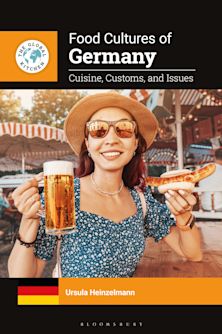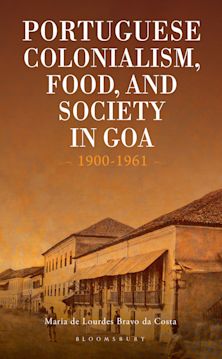- Home
- ACADEMIC
- Food
- Food History
- San Francisco Seafood
Payment for this pre-order will be taken when the item becomes available
You must sign in to add this item to your wishlist. Please sign in or create an account
Description
A deep dive into the history and evolution of San Francisco's seafood industry and what it teaches us about sustainability and cuisine today.
For early San Franciscans, seafood was an important source of nutrition and a feature of social life, inspiring culinary developments that remain components in California cuisine more than a century later. Consumers interested in flavorful alternatives to meat and associated health benefits could follow recipes for nearly fifty types of marine life from state waters, such as salmon, flounder, and oysters. Others are no longer available, out-of-vogue, or simply forgotten. Further, overfishing and environmental damage decimated many local seafood stocks, providing a cautionary tale with global significance.
In San Francisco Seafood: A History from Ocean to Table, Paul Stangl traces the development of San Francisco's fisheries, markets, and seafood culture from the Gold Rush to the 1920s. Migrants from around the world imported fishing techniques and cuisines, then slowly adapted as they came to understand local resources and each other. Newcomers found the tastiest fish through trial and error and assimilated the “best” into a new cuisine. Different ethnic and occupational groups collaborated, fought, and learned from one other as they irreversibly altered the natural world around them. By the end of the First World War, San Francisco's seafood cuisine scarcely resembled that of the 1850s, due to cultural adaptation, technological advancements, and changes to the natural environment. It was no longer derivative of New England and France, but included influences from the Southern states, Asia, and South America.
San Francisco Seafood chronicles the city's transformation from a fish-barren town-where restaurants served canned, pickled, and dried fish from the East Coast-to a seafood-rich metropolis that sold products across the continent from Mexico to Alaska. Stangl also emphasizes how the impacts on nature and local labor serve as a necessary cautionary tale for today's global seafood trade. This is a thorough and insightful history of a once emerging, and now essential, cuisine for food and history buffs alike.
Table of Contents
Chapter 1: Gold Rush Explorations
Chapter 2: Contested Fisheries
Chapter 3: The Shellfisheries
Chapter 4: A Matter of Taste
Chapter 5: Chinese Fisheries and Culinary Influences
Chapter 6: Monsters and Other Non-Foods
Chapter 7: Health and Environment
Chapter 8: The Rise of the Consumer
Conclusion: A Seafood Legacy
Bibliography
Notes
Index
About the Author
Product details

| Published | Apr 02 2026 |
|---|---|
| Format | Ebook (Epub & Mobi) |
| Edition | 1st |
| Extent | 240 |
| ISBN | 9798765145685 |
| Imprint | Bloomsbury Academic |
| Publisher | Bloomsbury Publishing |
About the contributors
Reviews
-
In this story of city, citizens, and sea, Stangl deftly weaves a whopper of a (true) fish tale. As he explores how seafood traditions reflect San Francisco's ever-changing cultural tides he recasts history in delicious color for curious cooks. Seafood truly is one of our first “heirloom” foods and this account shows why it's so important to understand and honor how the past seasons the present.
Barton Seaver, chef and author, “American Seafood”
-
Meticulously researched and yet extremely enjoyable to read, Paul Stangl's San Francisco Seafood: A History from Ocean to Table is a remarkable achievement in food studies, brilliantly showing the intersections of ethnicity, labor, food, the environment, and health. Those familiar with San Francisco's rich culinary culture will gain new insights into the multilayered and often contested process that produces it as well as the stories and contributions of diverse groups, such as Chinese shrimpers and Italian crabbers.
Yong Chen, author of “Chop Suey US” and “Chinese San Francisco”
-
Paul Stangl's San Francisco Seafood: A History from Ocean to Table is a deep dive into how fish and fisheries shaped the lives of coastal Californians. In this extensively researched book, Stangl explores the complex interplay of ecology, consumption, migration, labor, politics, and policy. For more than a century, the city's bond to the sea not only determined the future of the piscine populations of San Francisco Bay, but also the lives of the city's residents from the work they did during the day to the meals they ate at night. Historically, Stangl demonstrates, San Franciscans' fraught relationship to the sea was constantly evolving, reminding us that in the face of new environmental and social challenges it will need to continue to change.
Andrew P. Haley, author, “Turning the Tables: American Restaurant Culture and the Rise of the Middle Class, 1880-1920”
-
A rich, multi-perspectival history that reveals a striking paradox: San Francisco embraced shrimp and oyster cocktails as symbols of local identity while marginalizing the Chinese fishermen who pioneered these fisheries. Through portraits of New England salmon fishers, Italian trawler crews, and Chinese shrimpers, Stangl shows how diverse immigrants created California's distinctive seafood cuisine-and why some contributions were celebrated while others were overlooked.
Miranda Brown, Yi-tsi Mei Feuerwerker Collegiate Professor of Chinese Studies, University of Michigan
-
A great overview of the early history of Bay Area fisheries. A must read for any foodie, pescatarian, or seafoodista worth his herring roe!
Kirk Lombard, author, “The Sea Forager's Guide to the Northern California Coast”



































